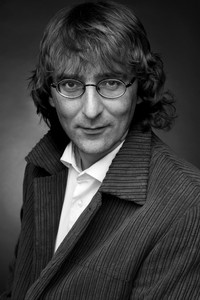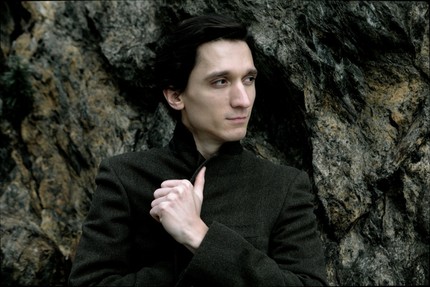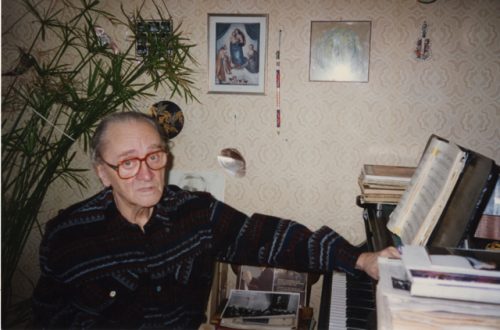
Konstantin Nikolaevich Igumnov (Konstantin Igumnov) |
Konstantin Igumnov

“Igumnov was a man of rare charm, simplicity and nobility. No honors and glory could shake his deepest modesty. There was not a shadow of that vanity in him, which some artists sometimes suffer from. This is about Igumnov the man. “A sincere and exacting artist, Igumnov was a stranger to any kind of affectation, posture, external gloss. For the sake of colorful effect, for the sake of superficial brilliance, he never sacrificed artistic meaning … Igumnov did not tolerate anything extreme, harsh, excessive. His playing style was simple and concise.” This is about Igumnov the artist.
“Strict and demanding of himself, Igumnov was demanding of his students as well. Astute in assessing their strengths and capabilities, he constantly taught artistic truth, simplicity and naturalness of expression. He taught modesty, proportionality and economy in the means used. He taught speech expressiveness, melodious, soft sound, plasticity and relief of phrasing. He taught the “living breath” of musical performance.” This is about Igumnov the teacher.
“Basically and most importantly, Igumnov’s views and aesthetic principles remained, apparently, quite stable … His sympathies as an artist and teacher have long been on the side of music that is clear, meaningful, truly realistic in its basis (he simply did not recognize another), his “credo” musician-interpreter has always revealed itself through such qualities as the immediacy of the performing embodiment of the image, the penetration and subtlety of poetic experience. This is about the artistic principles of Igumnov. The above statements belong to the students of the outstanding teacher – J. Milshtein and J. Flier, who knew Konstantin Nikolayevich very well for many years. Comparing them, one involuntarily comes to the conclusion about the amazing integrity of Igumnov’s human and artistic nature. In everything he remained true to himself, being a personality and an artist of deep originality.
He absorbed the best traditions of the Russian performing and composing schools. At the Moscow Conservatory, from which he graduated in 1894, Igumnov studied piano first with A.I. Siloti and then with P.A. Pabst. Here he studied music theory and composition with S. I. Taneyev, A. S. Arensky and M. M. Ippolitov-Ivanov and in chamber ensemble with V. I. Safonov. At the same time (1892-1895) he studied at the Faculty of History and Philology of Moscow University. Muscovites met the pianist Igumnov back in 1895, and soon he took a prominent place among Russian concert performers. In his declining years, Igumnov drew up the following scheme of his pianistic development: “My performing path is complex and tortuous. I divide it into the following periods: 1895-1908 – academic period; 1908-1917 – the period of the birth of searches under the influence of artists and writers (Serov, Somov, Bryusov, etc.); 1917-1930 – a period of reassessment of all values; passion for color to the detriment of rhythmic pattern, abuse of rubato; The years 1930-1940 are the gradual formation of my present views. However, I fully realized them and “found myself” only after the Great Patriotic War”… However, even if we take into account the results of this “introspection”, it is quite obvious that the defining features were inherent in Igumnov’s game in all internal “metamorphoses”. This also applies to the principles of interpretation and repertoire inclinations of the artist.
All experts unanimously note a certain special attitude of Igumnov to the instrument, his rare ability to conduct live speech with people with the help of the piano. In 1933, the then director of the Moscow Conservatory, B. Pshibyshevsky, wrote in the newspaper Soviet Art: “As a pianist, Igumnov is an absolutely exceptional phenomenon. True, he does not belong to the family of piano masters, who are distinguished by their brilliant technique, powerful sound, and orchestral interpretation of the instrument. Igumnov belongs to pianists like Field, Chopin, i.e. to the masters who came closest to the specifics of the piano, did not look for artificially caused orchestral effects in it, but extracted from it what is most difficult to extract from under the external rigidity of the sound – melodiousness. Igumnov’s piano sings, as rarely among modern great pianists. A few years later, A. Alschwang joins this opinion: “He gained popularity thanks to the breathtaking sincerity of his playing, live contact with the audience and excellent interpretation of the classics … Many rightly note the courageous severity in K. Igumnov’s performance. At the same time, Igumnov’s sound is characterized by softness, proximity to speech melody. His interpretation is distinguished by liveliness, freshness of colors. Professor J. Milshtein, who started as an assistant to Igumnov and did a lot to study the legacy of his teacher, repeatedly pointed out these same features: “Few could compete with Igumnov in the beauty of sound, which was distinguished by an extraordinary richness of color and amazing melodiousness. Under his hands, the piano acquired the properties of a human voice. Thanks to some special touch, as if merging with the keyboard (by his own admission, the principle of fusion lay at the heart of his touch), and also thanks to the subtle, varied, pulsating use of the pedal, he produced a sound of rare charm. Even with the strongest blow, his carcass did not lose its charm: it was always noble. Igumnov rather preferred to play quieter, but only not to “shout”, not to force the sound of the piano, not to go beyond its natural limits.
How did Igumnov achieve his amazing artistic revelations? He was led to them not only by natural artistic intuition. Reticent by nature, he once opened the “door” to his creative laboratory: “I think that any musical performance is a living speech, a coherent story … But just telling is still not enough. It is necessary that the story had a certain content and that the performer always had something that would bring him closer to this content. And here I cannot think of a musical performance in the abstract: I always want to resort to some everyday analogies. In short, I draw the content of the story either from personal impressions, or from nature, or from art, or from certain ideas, or from a certain historical epoch. For me, there is no doubt that in every significant work something is sought out that connects the performer with real life. I can’t imagine music for the sake of music, without human experiences… That’s why it is necessary that the performed work find some response in the personality of the performer, so that it is close to him. You can, of course, reincarnate, but there must always be some connecting personal threads. It cannot be said that I necessarily imagined the program of the work. No, what I imagine is not a program. These are just some feelings, thoughts, comparisons that help to evoke moods similar to those that I want to convey in my performance. These are, as it were, a kind of “working hypotheses”, facilitating the comprehension of the artistic conception.”
On December 3, 1947, Igumnov took to the stage of the Great Hall of the Moscow Conservatory for the last time. The program of this evening included Beethoven’s Seventh Sonata, Tchaikovsky’s Sonata, Chopin’s B Minor Sonata, Lyadov’s Variations on a Theme by Glinka, Tchaikovsky’s play Passionate Confession, unknown to the general public. Rubinstein’s Impromptu, Schubert’s A Musical Moment in C-sharp minor and Tchaikovsky-Pabst’s Lullaby were performed for an encore. This farewell program included the names of those composers whose music has always been close to the pianist. “If you still look for what is the main, constant in Igumnov’s performing image,” noted K. Grimikh in 1933, “then the most striking are the numerous threads connecting his performing work with the romantic pages of piano art … Here – not in Bach, not in Mozart, not in Prokofiev, not in Hindemith, but in Beethoven, Mendelssohn, Schumann, Brahms, Chopin, Liszt, Tchaikovsky, Rachmaninoff – the virtues of Igumnov’s performance are most convincingly revealed: restrained and impressive expressiveness, fine mastery of sound, independence and freshness of interpretation.
Indeed, Igumnov was not, as they say, an omnivorous performer. He remained true to himself: “If a composer is alien to me and his compositions do not personally give me material for performing arts, I cannot include him in my repertoire (for example, piano works by Balakirev, French impressionists, late Scriabin, some pieces by Soviet composers).” And here it is necessary to highlight the pianist’s incessant appeal to the Russian piano classics, and, first of all, to the work of Tchaikovsky. It can be said that it was Igumnov who revived many of the works of the great Russian composer on the concert stage.
Everyone who has listened to Igumnov will agree with the enthusiastic words of J. Milstein: “Nowhere, even in Chopin, Schumann, Liszt, Igumnov’s special, full of simplicity, nobility and chaste modesty, is expressed so successfully as in the works of Tchaikovsky. It is impossible to imagine that the subtlety of performance can be brought to a higher degree of perfection. It is impossible to imagine greater smoothness and thoughtfulness of melodic outpourings, greater truthfulness and sincerity of feelings. Igumnov’s performance of these works differs from others, as an extract differs from a diluted mixture. Indeed, everything in it is amazing: every nuance here is a role model, every stroke is an object of admiration. To evaluate the pedagogical activity of Igumnov, it is enough to name some of the students: N. Orlov, I. Dobrovein, L. Oborin, J. Flier, A. Dyakov, M. Grinberg, I. Mikhnevsky, A. Ioheles, A. and M. Gottlieb, O. Boshnyakovich, N. Shtarkman. All of these are concert pianists who have gained wide popularity. He began teaching shortly after graduating from the conservatory, for some time he was a teacher at the music school in Tbilisi (1898-1899), and from 1899 he became a professor at the Moscow Conservatory; in 1924-1929 he was also its rector. In his communication with his students, Igumnov was far from any kind of dogmatism, every lesson of his is a living creative process, the discovery of inexhaustible musical riches. “My pedagogy,” he says, “is closely connected with my performance, and this causes the lack of stability in my pedagogical attitudes.” Perhaps this explains the amazing dissimilarity, sometimes the contrasting opposition of Igumnov’s pupils. But, perhaps, all of them are united by a reverent attitude towards music, inherited from the teacher. Saying goodbye to his teacher on a sad day of requiem. J. Flier correctly identified the main “subtext” of Igumnov’s pedagogical views: “Konstantin Nikolaevich could forgive a student for false notes, but he did not forgive and could not stand false feelings.”
… Talking about one of his last meetings with Igumnov, his student Professor K. Adzhemov recalled: “That evening it seemed to me that K.N. was not quite healthy. In addition, he said that the doctors did not allow him to play. “But what is the meaning of my life? Play…”
Lit .: Rabinovich D. Portraits of pianists. M., 1970; Milshtein I, Konstantin Nikolaevich Igumnov. M., 1975.
Grigoriev L., Platek Ya.





